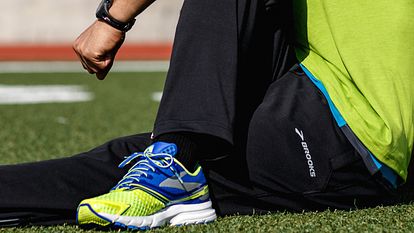Reduce Your Running Footprint with These Sustainability Efforts

Sustainability is an important and complicated issue. As runners, most of us value the great outdoors and want to do our part to protect the places we love. This takes conscious effort and intention.
Modern living creates a staggering amount of waste—much of it from single-use plastic. While running is a simple sport that doesn’t require a ton of gear, the reality is that we continually use up our clothing, shoes, gear and nutrition, typically sending the leftovers to a landfill to sit for decades.
What can we do about this? Start small and be strategic.
You have choices to make every day about the easily accessible items that make your life more convenient but create waste. Every little action matters.
“It’s like voting,” says Nick Stump, operator of Fleet Feet Del Ray in Florida. “You may not think that your vote counts, but it does. We have to do our own part to make our world a little bit better.”
Stump has begun making changes at his Florida store, like eliminating single-use plastic bags and cutting down on unneeded paper.
“We try to find ways to be more efficient with our lives and make them more enriching,” Stump says. “We can look for another opportunity to do something a little bit better, even if it’s just small, minor steps. You have an obligation to yourself and your kids or future generations to do your part.”
As we wait for big retailers to catch on and offer better alternatives to the less environmentally friendly options, here are a few suggestions for runners to reduce your impact.
The best place to start is to think about the impact of the items you purchase and consume on a regular basis. What kind of packaging do they have? How long do you use them before you throw them away? What small changes can you make?

Plan ahead and prepare
This happens to be the first of seven Leave No Trace Principles. The problem with single-use plastic is that these products are absolutely everywhere. It is easy to take a cheap plastic item such as a bag or water bottle, use it once, and send it to a landfill to remain for decades.
It’s not difficult to quit a plastic habit, but it does take prior planning. If you don’t want to live in a world where you unknowingly consume a credit card-sized amount of microplastic per week, consider the changes you want to make and the ways you can alter your habits. Businesses will follow consumer demand.
BYO reusable bottle
Hydration is crucial, but you don’t need water held in those cheap plastic bottles. The quality of tap water in most major cities is generally as good or better than bottled water, without the devastating environmental pollution that comes from single-use plastic water bottles or cups. Whether you’re meeting friends for a run or traveling to a race, get your own reusable bottle and drink from it again and again.
Many races provide hundreds of plastic water bottles to runners. Most also have jugs or water fountains where you can refill your reusable bottle. Plan ahead, and bring plenty of water for yourself. Don’t take the plastic bottles just because they are free, available and convenient.
Return wrappers to Terracycle
If you are a runner, you have probably consumed packaged nutrition products, such as bars or gels, to fuel your runs. You also know that you should never, ever throw your nutrition wrappers on the ground. Did you know that there is a better place to send those wrappers than the trash can?
If you want to go the extra mile to reduce waste, you can send wrappers to specialized recycling services like Terracycle to give them a new life outside of the landfill. Terracycle accepts difficult-to-recycle items, like nutrition wrappers, running shoes and pens. It then breaks down those items to repurpose into a type of plastic used to create practical, reusable items, like watering cans and park benches.
Getting those products to Terracycle, however, can take some effort, and most people won’t go out of their way to mail these wrappers to the company. GU Energy wants to make that easier.
GU stepped in to make Terracycle available to all. GU provides pre-paid shipping labels with a simple online registration, making it easy to collect and send packages to Terracycle to be diverted from the landfill.
Saving wrappers is a new habit for most of us, and it takes practice and effort to remember not to put them in the trash. But turning that trash into useful products makes the effort worth it.

Support races that produce less waste
Directing a race is not an easy task. From planning routes and getting approval to marketing and setting up, there’s a lot to be done.
Races can also create a huge environmental impact simply because they bring so many people to one area.
There is a growing number of race directors who use their races to reduce race waste while providing an outstanding experience for participants. Many races will go cupless, asking runners to bring their own reusable vessels to refill at aid stations (as opposed to providing hundreds of plastic or paper cups). Others provide Terracycle boxes to collect nutrition wrappers to be recycled. Support low-waste races as much as you can, whether it’s as a runner or a volunteer.
If you have a caffeine routine, cut your daily waste
Not everyone drinks coffee or tea, but many runners do.
Caffeine makes exercise feel easier. If this is your daily habit, you can reduce waste by using a pour-over or French press rather than plastic single-use pods for coffee. If you drink tea, loose-leaf is similarly easy and avoids the use of tea bags.
These methods drastically reduce waste and don’t take long to make. You can compost your coffee grounds or tea leaves instead of putting them into the trash. This also reduces methane gas created by organic matter in landfills.
If you like to go to a coffee shop, bring your own insulated mug instead of taking a disposable cup. Your drink will stay hot longer, and you’ll likely get a discount for skipping the cup.
Disposable coffee cups, while mostly made of paper, are lined with polyethylene plastic. This makes them capable of holding hot liquid. Each one takes around 30 years to break down in a landfill. Even though many of them say they are recyclable, they are actually not accepted by most recycling facilities.
Avoid driving
Run from home when you can. Carpool with friends when it makes sense, and run-commute to work if you’re able to. If it’s accessible, bike to your run location. Of course, it isn’t practical to do this every single day. But every little bit helps. Get creative, mix it up, and make it fun! It can make your running life a lot more interesting and also save gas, wear and tear on your car, and time spent getting stiff muscles while you drive home.
Go plogging
The Swedish gave us the fartlek, and now they bring us plogging. In Swedish, “Plocka Upp” means “pick up,” as in, “pick up litter.” Mix it with jogging and you have “plogging.” No matter the name, it’s a great way to beautify a place you love while you exercise. The concept isn’t exactly new, but it’s a wonderful way to care for your community. Take a bag, some gloves, and set out plogging when you’re ready for a low-key run, or want to get in some extra miles.
Volunteer
If you want to see a low-waste race in your area, let race directors know, and offer to help. Bring friends. Provide support for sustainable practices where you live and be part of the solution.
As a race volunteer, you can be sure that waste is disposed of properly and connect with race officials to talk about sustainability. It shows that you are willing to do your part to create positive change.
By Kate Schwartz. Schwartz has been running competitively for 20 years, and she currently runs with the Asheville Running Collective. She lives in Asheville, NC, with her husband, Alex, and their cat, Clementine.



Join our Newsletter
Get deals, events, and more.
Connect with Fleet Feet
Get involved on social media.
Find a Location
Fleet Feet has over 250 locations nationwide!
Find a Store